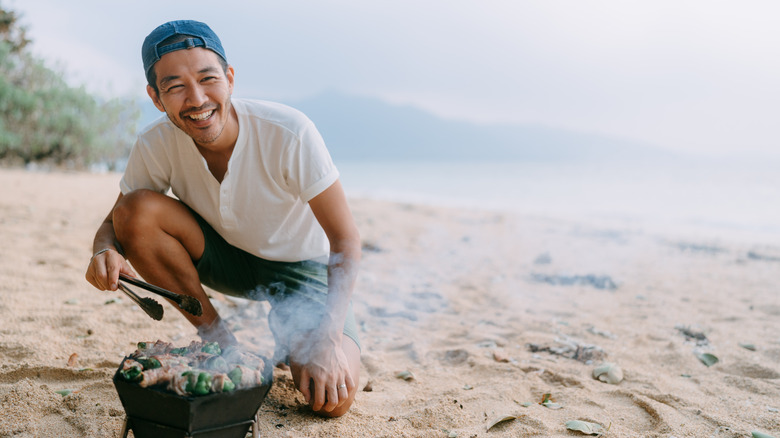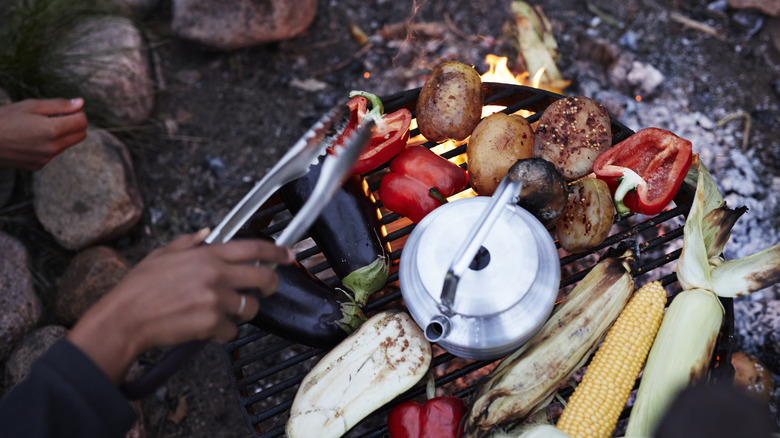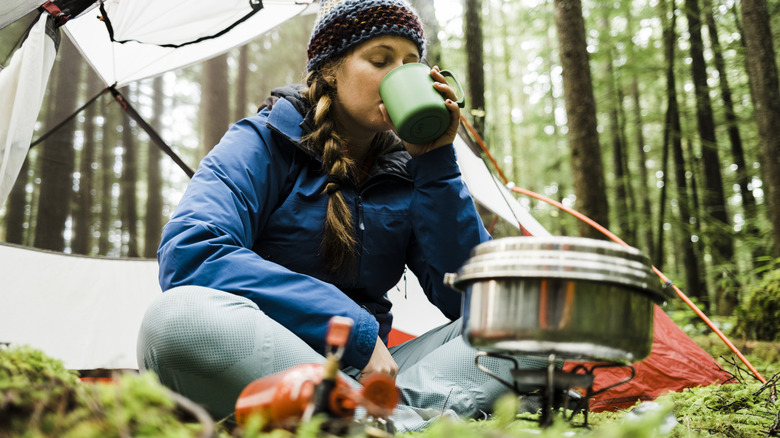This Simple Step Is A Game-Changer For Hassle-Free Cooking While Camping
Sleeping under the stars, waking up to the sound of birdsong, ditching screens and technology — camping reconnects you with nature in ways that few other activities can. From breathing all the fresh air to enjoying the stunning views, giving up the comforts of home for a weekend (or more!) of outdoor adventure means going back to basics in all the best ways. That said, successful camping trips — aka, ones that don't involve missing essentials or weather disasters — actually require a lot of careful planning. And although things like choosing the right tent for your camping adventure and finding the perfect spot to set up camp might seem obvious, there's one more major consideration that also deserves attention: what you're planning to eat during all that time in the wilderness.
After all, when you're camping for multiple days, food becomes an essential part of your experience. Because, unlike your kitchen back home, campsite cooking doesn't offer all of the same conveniences. On the contrary, it actually comes with a long list of limitations. Once you're outside, things like restricted cooking equipment, little to no access to refrigeration, and challenging dish cleanup situations all combine to create a cooking experience that's pretty unique and a little intimidating.
Thankfully, though, there's an easy way to prepare that experienced campers swear by for convenience: meal prepping and planning before the trip. Ultimately, by deciding what you're going to eat for each meal ahead of time (including preparing all of the ingredients in advance), you can eliminate the stress of trying to figure it out on the spot. Plus, planning ahead also reduces food waste, minimizes packing space, and even ensures that you'll actually enjoy what you eat instead of just resigning yourself to suffer through yet another bland camping meal.
Tips for successfully planning delicious camp meals
The best place to start is by creating a detailed meal plan for each day of your trip. Depending on your schedule, you'll want to include breakfast, lunch, dinner, and any other potential snacks you might want to enjoy. This will help you create an accurate grocery list to follow, as well as prevent you from overpacking (and potentially wasting) food. A great place to go for inspiration is Pinterest. Alternatively, using a tool like ChatGPT is also a great option to help you create a more personalized menu with everything from ingredients you actually like to dietary restrictions, portion sizes, and cooking methods.
Once you've planned your menu, you can then go ahead and prep any necessary ingredients at home to streamline cooking at your campsite. For example, measure out spice blends into straws to avoid bringing entire containers. For even more convenience, cut up veggies and store them in reusable silicone bags to help maintain their freshness. Can't fathom the thought of waking up to no caffeine? Pre-grind your coffee beans and store them in a sealed container for easy brewing. Lastly, for meat dishes, marinate proteins the day before in sealed bags, and make sure to store them in your cooler with plenty of ice to prevent them from spoiling.
As a final tip, look for ingredients that can serve multiple purposes across different meals. A bag of shredded cheese might work for breakfast burritos (which you can pre-prep) and pasta, while a small tub of hummus can double as a sandwich spread or a dip for vegetables. Additionally, it's also worth considering what foods can be fully cooked at home and simply reheated at camp, which will cut down on any prep outdoors.
More food tips to help improve your camping experience
Before you start chopping up vegetables and pouring pasta portions into their own resealable bags, it's important to think about what cooking gear you'll have available. This includes utensils, pots, and even heat sources. For example, cast iron pans are great for whipping up hearty breakfasts, foil packets make most dinner cleanups a breeze, and portable stoves give you immediate access to consistent heat. Ultimately, picking and packing recipes that actually match your equipment will make the whole cooking process much easier.
Additionally, your food storage situation also matters. If you're planning on using just a cooler with ice, you'll want to eat perishable foods like meat, cheese, and fresh vegetables during the first days of your trip to avoid spoilage. As a pro tip, we suggest you use an ice block (instead of ice cubes) since it'll last a lot longer and won't melt as quickly. Meanwhile, save foods that don't need to be refrigerated — like dry (uncooked) pasta, nuts, and certain fruits — for later in your adventure. Cooked pasta and rice need to be kept cold to slow down any mold growth, and can be dangerous to eat if left at room temperature for more than four to six hours.
Finally, there's the issue of preventing a potential wildlife encounter. After all, sleeping, cooking, and eating outside make for a perfect recipe for inviting animal visitors. That said, in order to avoid drawing the attention of any curious critters (or, worse, a hungry bear), make sure to always pack your food safely using bear-proof containers, especially at night. Additionally, never leave any food sitting out at your campsite, and make sure you always clean your cooking area and utensils after each meal. Lastly, before leaving the campsite, make sure that you safely dispose of any food waste or pack it with you to avoid attracting wildlife to your site even after you're gone.


